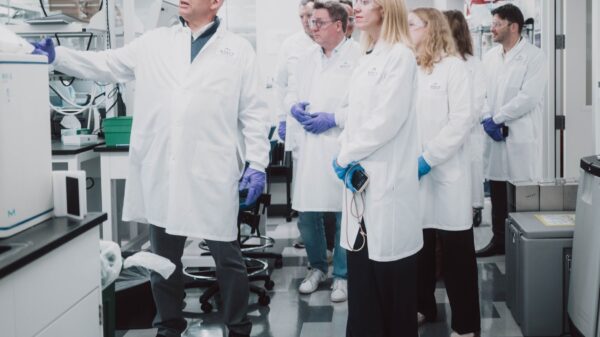Shares of health sciences company, Prenetics Global Limited (NASDAQ: PRE), rose by over 40 per cent on the back of a strong financial showing in 2024 and ambitious revenue predictions for 2025.
Prenetics has garnered attention due to its ambitious revenue outlook for 2025. The company previously reported a 93.5 per cent revenue increase to USD$10.5 million in Q4 2024 and a 40.9 per cent year-over-year growth to USD$30.6 million for the full year.
More notably, the company projects 2025 revenue to range between USD$73 million and USD$85 million, implying a potential growth of 350–450 per cent compared to 2024. This forecast, driven by its consumer health brands like IM8 Health, Europa, and CircleDNA, has bolstered investor confidence in the company’s growth trajectory.
Prenetics has also recently announced a partnership with decentralized identity verification system, Humanity Protocol.
It’s integrating its genetic testing technology with decentralized identity verification, positioning the company at the forefront of health data analytics and innovation.
Additionally, the launch of IM8 Health’s NSF Certified for Sport Daily Ultimate Essentials supplement, endorsed by high-profile figures like David Beckham, has enhanced the brand’s credibility and market appeal.
Wall Street analysts have set a 12-month price target of USD$9.00 to USD$13.00 for Prenetics, suggesting a potential upside of 74.59 per cent to 106.3 per cent from recent trading levels around USD$6.30–$8.09.
The consensus “Buy” rating reflects confidence in Prenetics’ ability to outperform the market, particularly due to its advancements in diagnostic testing and consumer health solutions.
Read more: Breath Diagnostics pioneers novel lung cancer breath test
Read more: Breath Diagnostics takes aim at lung cancer with One Breath
Global cancer diagnostics market is growing rapidly
Prenetics operates across three core segments: prevention, early detection, and treatment.
In the prevention space, the company offers DNA testing through its consumer brand, CircleDNA. These tests use next-generation sequencing to provide insights into health, wellness, and genetic risks. CircleDNA helps individuals make informed lifestyle and health decisions.
In addition, Prenetics targets early cancer detection through a joint venture called Insighta. This USD$200 million collaboration with Professor Dennis Lo and the Chinese University of Hong Kong focuses on multi-cancer screening. Insighta is developing a blood test expected to detect over 10 types of cancer by 2027.
Also, the company addresses treatment through ACT Genomics, its precision oncology arm. This division provides advanced genomic profiling with panels such as ACTOnco and ACTHRD. It also offers liquid biopsy tests like ACTLiquid Pro, which guide personalized cancer therapy.
The global cancer diagnostics market is growing rapidly due to rising cancer rates, better technology, and increased focus on early detection. In 2025, estimates place the market size around USD$115 to USD$116 billion. Analysts project it could reach up to USD$199.54 billion by 2034, growing at a compound annual growth rate (CAGR) between 6.14 and 8.62 per cent. This growth reflects not only medical demand but also innovations in how cancer is detected and diagnosed.
North America currently leads the market.
In 2024, the U.S. alone generated USD$41.47 billion in cancer diagnostics revenue.
Experts expect that figure to grow to USD$59.53 billion by 2030, supported by strong healthcare infrastructure and widespread screening programs. Conversely, the Asia-Pacific region is expected to grow the fastest. Its expansion comes from increasing cancer awareness, healthcare reforms, and an aging population.
Read more: Breath Diagnostics now offering a compelling investment opportunity
Read more: Breath Diagnostics gives the public the chance to join the fight against cancer
Next generation cancer detection is non-invasive
Technological innovation also plays a key role.
Next-generation sequencing (NGS), artificial intelligence, and liquid biopsies allow for faster and more precise diagnoses. For example, the U.S. next-generation cancer diagnostics market may double from $5.53 billion in 2025 to over $11 billion by 2034. These tools offer non-invasive, real-time insights that guide treatment decisions and improve patient outcomes.
Next-generation cancer detection techniques are revolutionizing early diagnosis through non-invasive, rapid, and cost-effective methods.
Among the innovators in this field is Breath Diagnostics, whose OneBreath technology analyzes exhaled breath to detect lung cancer. Unlike traditional low-dose CT scans, which involve radiation and can yield high false-positive rates, OneBreath utilizes a patented microreactor to stabilize volatile organic compounds (VOCs) in the breath.
These VOCs are then analyzed using ultra-high-performance liquid chromatography-mass spectrometry (UHPLC-MS). The tech has achieved 94 per cent sensitivity and 85 per cent specificity in clinical trials involving over 800 patients. This approach reduces false positives and eliminates radiation exposure, offering a safer and more accessible screening option.
Additionally, startups like SpotitEarly are developing breath-based diagnostics capable of detecting multiple cancer types. These types include includ breast, lung, colorectal, and prostate cancers, from a single at-home breath sample.
.
joseph@mugglehead.com














